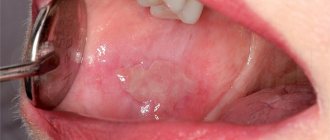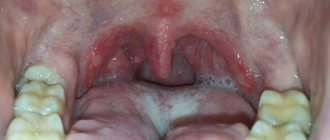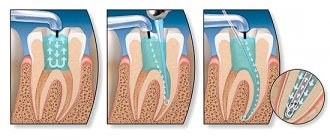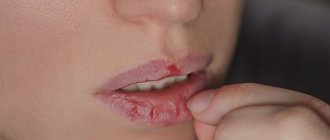Bubbles with yellowish contents on the mucous membrane of the cheeks, back of the tongue, and lips cause pain to the baby and are accompanied by drooling and low-grade fever. Active children become lethargic, sleep restlessly, and are capricious. This is how herpetic stomatitis manifests itself - damage to the mucous membrane provoked by the type I herpes virus. The disease is not dangerous if treated correctly. In the absence of medical supervision or self-medication, the symptoms disappear, but a chronic form may develop, laryngitis, and conjunctivitis may develop.
Herpetic stomatitis in children: general information
Children from six months of age to 5 years are most vulnerable to infection. By 6 months, the protective antibodies received from the mother are gradually eliminated, and one’s own immunity is still weak. The virus is transmitted from parents through licked nipples and spoons, and kisses.
Herpetic stomatitis in a 2-year-old child appears during the first active contacts with children. Infection occurs through toys and dirty hands. At 3–6 years old, the child goes to kindergarten, attends clubs and sections. Adaptation to a team, stress, psycho-emotional tension weaken the immune system. Therefore, acute herpetic stomatitis (AHS) in pediatric dentistry is the leader among inflammations of the oral cavity.
In addition to weak immunity, the development of stomatitis is facilitated by:
- Failure to comply with hygiene rules.
- Hypothermia and overheating.
- Damage to the mucous membrane.
- Past ENT diseases, ARVI.
- Poor diet and vitamin deficiency.
Classification of childhood stomatitis
Stomatitis is classified according to the reason for its occurrence. There are several types, each of which has the following list of characteristic features:
1.
Herpetic or herpes stomatitis
It is important to find out the cause
The most common type of stomatitis, diagnosed in 80% of 100% cases. Occurs in children between the ages of one and four years. The source of the disease is the herpes virus, which can be transmitted not only through airborne droplets, but also through objects used in everyday life. Symptoms characteristic of this species include: high body temperature (can reach 38-39 degrees), general condition sluggish and weakened, rashes in the lip area. And in some cases, cough and rhinitis even appear. Subsequently, approximately on the second or third day of the current illness, the lips, tongue and the inside of the cheeks become covered with small wounds - aphthae, which are the main sign of herpetic stomatitis. This is where another name for childhood stomatitis comes from - aphthous. Aphthae have rounded shapes of a yellowish-gray hue with bright red inflamed edges. The appearance of ulcers is accompanied by bleeding gums and a characteristic odor from the mouth. It should be concluded that it is the herpetic type of disease that can occur in a severe form, in which the body is subjected to severe intoxication.
Viral stomatitis can appear along with other viral diseases such as influenza, chicken pox, measles, etc. Treatment of viral stomatitis is most often carried out with antibiotics, which are prescribed by a doctor after diagnosis.
Painful sensations
This variety is common among the school and preschool age groups. Often appears as a result of inflammatory processes in the body (sore throat, sinusitis, pneumonia). The characteristic signs of the disease include: lips stuck together and covered with a thick crust, opening the mouth occurs with great difficulty, elevated temperature. Stomatitis of microbial origin occurs in a child if the immune system is weakened. The period of autumn and winter is especially dangerous for such children.
3.
Traumatic stomatitis
One of the types of childhood stomatitis in preschool children, which can be caused by physical damage to the oral cavity. These include: burned mucous membrane due to the consumption of hot food (tea, soup, porridge), biting the tongue, lips or cheeks while chewing, injury from a pencil, toy or some other object.
4.
Candidal stomatitis
Infants are susceptible to candidal or fungal stomatitis. At the end of breastfeeding, mother's milk can remain in the baby's mouth, which is a favorable environment for the development and reproduction of fungi, namely the genus Candida. This is where the name that parents give to stomatitis comes from, thrush. A white coating on the tongue and in the mouth, poor appetite and a fairly slow weight gain of the baby are clear signs of this. But in no case should it be confused with plaque after feeding. The reason for concern is if the plaque does not disappear.
5.
Allergic stomatitis
It is considered a particularly rare species. The cause is allergic reactions to dust, plants, wool, medications, food, etc. Manifests itself in the form of rashes in the mouth and swollen mucous membranes. Sometimes accompanied by elevated body temperature.
Symptoms of herpetic stomatitis
The severity of acute syndrome is determined by the combination of the severity of mucosal lesions and general symptoms (fever, headache, vomiting). With herpetic stomatitis, there is no transition from stage to stage - either immediately mild, severe, or moderate. In children, general symptoms prevail over local ones; even with minor inflammation of the mucous membrane, low-grade fever and weakness are observed.
Mild form of OGS. The rash is preceded by a rise in temperature to 37.5°C. After 1–2 days, catarrhal gingivitis develops (swelling, darkening, bleeding in the gingival margin). Salivation increases, and the submandibular lymph nodes may enlarge. Against the background of inflammation of the gums, bubbles (up to 3-5 pieces) appear in the mouth, which quickly open and turn into small ulcers with a white coating and reddened edges. Herpetic stomatitis on the tongue causes pain when talking, chewing, children refuse to eat. The rash appears once. After 1–2 days, the temperature returns to normal, swelling of the gums, pain and burning in the mouth decrease. Erosion heals without scars within 5–7 days.
Moderate degree of AHS. The onset of the disease is indicated by a slight increase in temperature, physical malaise, soreness and hardening of the submandibular and cervical lymph nodes. After a day or two, the part of the gum surrounding the teeth swells, turns red and aches, and the temperature rises to 38℃. On the reddened mucous membrane of the mouth and the skin of the perioral area, blisters appear in the amount of 5–15 pieces; they can unite into large painful ulcers with pink outlines and reappear. How long it takes for a child to get herpetic stomatitis depends on immunity, timeliness and effectiveness of treatment. Typically, the peak period of the disease lasts 7–10 days. Without adequate treatment, a herpetic infection can spread to the conjunctiva of the eyes, and ulcerative gingivitis with bleeding erosions, damage to the oropharynx, and deformation of the gingival papillae can develop.
Severe form of OHS. It develops rarely, in most cases in children with immunodeficiency. Already at the beginning of the disease, the lymph nodes in the neck and under the jaw become inflamed, and the temperature rises to 40℃. The swollen mucous membrane bleeds; after a day, bubbles form in the oral cavity, near the lips. New rashes appear repeatedly, you can see a vesicular rash at different stages of healing, merging erosions. Recovery is long (14 days or more), herpetic stomatitis can become recurrent and periodically worsen.
If you notice a rash in your child’s mouth or lips, sign up for a consultation. Our pediatric dentists and periodontist will find a common language with the little patient and quickly alleviate the condition.
Acute herpetic stomatitis
As already mentioned, the disease is caused by a virus. Both adults and children are at risk.
So, what is this disease?
The main symptoms of herpetic stomatitis are inflammation of the mucous membrane and aphthae (shallow ulcers and erosions) of the oral cavity.
The disease is highly contagious and can spread quickly to people who have never been infected with the herpes simplex virus.
In most cases, children under three years of age are susceptible to stomatitis, and less often, adolescents and young people.
Initially, there are complaints of deterioration in health with an increase in body temperature from 38°C. As a result of the examination, a slight increase in the cervical and jaw lymph nodes is revealed.
The gums become swollen and red, and small blisters appear filled with clear liquid. The bubbles “burst”, which leads to the appearance of erosions. Aphthae form within 3-5 days.
Patients complain of a feeling of discomfort, burning and itching while chewing food. To ensure that the patient’s condition does not worsen, treatment should be started on time. If the correct therapy is prescribed, the patient will fully recover within 10 days.
If treatment is not followed, then over time, the number of erosions increases, which contributes to the deterioration of the patient’s condition and an increase in body temperature to 39-40.5 ° C.
Herpetic stomatitis manifests itself in mild, moderate and severe stages.
The mild form presents with weakness, malaise and nausea. Temperature is within normal limits. There are a couple of small bubbles in the mouth. The mucous membrane heals quickly.
The moderate form of herpetic stomatitis in patients is manifested by malaise and nausea. Body temperature reaches 38°C. There are a large number of rashes in the mouth.
Nausea, diarrhea and vomiting are the main symptoms of this disease in severe form. Temperature 38.5 - 40°C. There are multiple lesions in the mouth. The presence of all signs of an infectious disease.
To accurately confirm the diagnosis, the dentist prescribes a general blood test and, if necessary, other laboratory tests.
Treatment of herpetic stomatitis at the “Family Dentist”
Therapy for OHS is complex; in mild to moderate cases, it is carried out at home. The dentist prescribes medications, gives recommendations on nutrition and oral hygiene. The cost of an appointment in our clinic is from 10 rubles.
When herpetic stomatitis is diagnosed in children, the treatment regimen includes:
- Diet. Food should be liquid or semi-liquid (mashed soups, vegetable purees, cereals, jelly, yoghurts, minced meat and fish) at a comfortable temperature. In case of extensive erosions, it is advisable to feed the baby liquid food through a tube.
- Prevention of dehydration. Water balance is maintained with dried fruit compotes, broths, plain water, and a weak rosehip decoction.
- Oral hygiene. To prevent the development of a secondary infection, teeth should be cleaned with a soft brush without paste, and the mucous membrane should be treated with a swab and a warm antiseptic solution. You should rinse your mouth every time after eating.
- Local, general therapy. The drugs are prescribed by the dentist, taking into account the severity of the acute syndrome.
Mild degree. Ulcerations of the mucous membrane are treated 3-4 times a day with a cotton pad or bandage soaked in a solution of chlorhexidine 0.05% or miramistin. If necessary, the doctor prescribes an antiviral ointment. If there is no risk of seizures, antipyretic drugs are not prescribed.
Moderate degree. At the height of herpetic stomatitis, treatment with local antiseptic solutions is supplemented with tableted antiherpetic drugs, if the rash does not begin to dry out on the 2nd–3rd day. Medicines have an effect on the entire body, therefore they are taken only as prescribed by a doctor. The mucous membrane after a viral infection is restored with healing agents with vitamins A, E, and sea buckthorn oil. To reduce pain, lidocaine gel is applied to the mucous membrane 20 minutes before meals.
Severe degree. The dentist refers you to the hospital, treatment is carried out with injectable drugs, immunostimulants, and physiotherapy is prescribed.
To make an appointment at the “Family Dentist” in Minsk, fill out the form or call. You don't have to stand in line with a sick child.
What is stomatitis?
Stomatitis is the most common disease of the oral mucosa, which is accompanied by inflammatory processes of various origins. The term is derived from the Latin word "stoma", which means mouth. From the moment a person is born, his mucous membrane is exposed to influences from the external environment: microorganisms and unwanted mechanical influences that can harm it and cause injury. As a result, the mucous membrane may become inflamed and ulcers may form at the site of damage. Stomatitis occurs in everyone, regardless of the number of years lived, although most often infants and preschool children have to deal with it due to the fact that it is at this time that the mucous membrane is more vulnerable. Treatment of stomatitis in children is a medical problem that must be solved by a doctor.
Children and herpetic stomatitis
In childhood, the disease is more severe than in adults, and begins with a sharp increase in body temperature (38°C or more). The child's lymph nodes enlarge, the baby becomes irritable and is capricious a lot.
Stomatitis is detected after examination by an oral cavity specialist: the gums become swollen, take on a bright red tint and constantly bleed; rashes appear on the second or third day of the disease.
From time to time, the child may have his mouth slightly open, from which saliva flows, and it is painful for him to swallow.
When examining the baby's mouth area, grouped blisters are observed. Please note that the bubbles open after a while, which is accompanied by pain in the child’s mouth, he refuses to eat, cries constantly and sleep is disturbed.
The erosions that form in the mouth will gradually become covered with a white coating, and after a few days, the mucous membrane will clear up and heal.
In children, the disease manifests itself in different stages.
In mild cases of herpetic stomatitis, rashes appear exclusively in the oral cavity; treatment at home is allowed (be sure to call a doctor).
Moderate and severe degrees of the disease are characterized by rashes not only in the oral cavity, but also in the mouth area. Children aged 1 to 4 years should be hospitalized in any case.
A child with acute herpetic stomatitis must be isolated in a separate room, which should have low lighting (bright light will irritate the patient).
The child should be provided with separate dishes.









